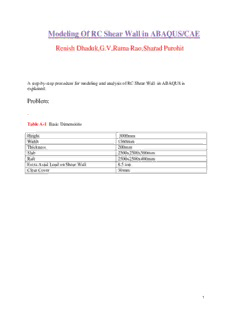
Modeling Of RC Shear Wall in ABAQUS/CAE PDF
Preview Modeling Of RC Shear Wall in ABAQUS/CAE
Modeling Of RC Shear Wall in ABAQUS/CAE Renish Dhaduk,G.V,Rama Rao,Sharad Purohit A step-by-step procedure for modeling and analysis of RC Shear Wall in ABAQUS is explained. Problem: . Table A-1 Basic Dimensions Height 3000mm Width 1560mm Thickness 200mm Slab 2500x2500x500mm Raft 2500x2500x400mm Extra Axial Load on Shear Wall 8.5 ton Clear Cover 30mm 1 Figure B–1 Detailed Detailing Of Shear Wall 2 To create the RC Shear Wall: 1. Start Abaqus/CAE 2. From the Start Session dialog box that appears, select Create Model Database. If you are already in an Abaqus/CAE session, select File New from the main menu bar. 3. Select File Set Work Directory 4. In the Part Module click (or double-click the Parts container in the Model Tree) to create a new part. The Create Part dialog box appears. Abaqus/CAE also displays text in the prompt area near the bottom of the window to guide you through the procedure. You use the Create Part dialog box to name the part; to choose its modeling space, type, and base feature; and to set the approximate size. You can edit and rename a part after you create it; you can also change its modeling space and type but not its base feature. 5. Name the part Wall. Accept the default settings of a three-dimensional, deformable body and a solid, extruded base feature. In the Approximate size text field, type 300. 6. Click Continue to exit the Create Part dialog box. 7. To sketch the profile of the Wall, you need to select the rectangle drawing tool . 8. In the viewport, sketch the rectangle using the following steps: a. You will first sketch a rough approximation of the beam and then use constraints and dimensions to refine the sketch. Select any two points as the opposite corners of the rectangle. b. Click mouse button 2 anywhere in the viewport to exit the rectangle tool. Note: If you are a Windows user with a 2-button mouse, press both mouse buttons simultaneously whenever you are asked to press mouse button 2. c. The Sketcher automatically adds constraints to the sketch (in this case the four corners of the rectangle are assigned perpendicular constraints and one edge is designated as horizontal). d. Use the dimension tool to dimension the top and left edges of the rectangle. The top edge should have a horizontal dimension of 1560 mm, and the left edge should have a vertical dimension of 3000 mm. When dimensioning each edge, simply select the line, click mouse button 1 to position the dimension text, and then enter the new dimension in the prompt area. e. The final sketch is shown in Figure B–2. 3 Figure B–2 Sketch of the rectangle. Because you are creating an extruded part, Abaqus/CAE displays the Edit Base Extrusion dialog box for you to select the depth. Optional parameters to modify the extrusion shape are also available. In the Depth field, erase the default value and type a value of 200. Click OK to accept this value. Abaqus/CAE displays an isometric view of the new part, as shown in Figure B–3. 4 Figure B–3 Isometric view of the wall. Before you continue the tutorial, save your model in a model database file. . From the main menu bar, select File Save. The Save Model Database As dialog box appears. a. Type a name for the new model database in the File Name field, and click OK. You do not need to include the file extension; Abaqus/CAE automatically appends .cae to the file name. Abaqus/CAE stores the model database in a new file and returns to the Part module. The title bar of the Abaqus/CAE window displays the path and name of the model database. You should always save your model database at regular intervals (for example, each time you switch modules). f. Same way create other parts as per dimension given in data. 5 1) Top slab 2) Bottom Raft 3) Vertical Bar in wall 4) Horizontal Bar in wall 5) X-Direction Bar in top slab 6) Z-Direction Bar in top slab 7) X-Direction Bar in bottom raft 4. Creating a Material To define a material: 1. In the Property module, click (or double-click the Materials container in the Model Tree) to create a new material. 2. Name the material Steel. Use the menu bar under the browser area of the material editor to reveal menus containing all the available material options. Some of the menu items contain submenus; for example, Figure below shows the options available under the Mechanical Elasticity menu item. When you select a material option, the appropriate data entry form appears below the menu. Figure B–7 Submenus available under the Mechanical menu. 3. From the material editor's menu bar, select Mechanical Elasticity Elastic. Abaqus/CAE displays the Elastic data form. 4. Type a value of 27386.13 for Young's modulus and a value of 0.18 for Poisson's ratio(For M30 Grade concrete) in the respective fields, as shown in Fig. Use [Tab] to move between cells. 6 Figure B–8 Entering data values for the elastic material properties. 5. For plasticity Properties, Mechanical Plasticity Plastic 7 8 5. Same way enter properties for steel rebar. 9 Plastic Properties: Stress(MPa) Strain Stress(MPa) Strain 13.5 0 391.39 0.0023 26.092 0.0001 417.48 0.0025 52.185 0.00025 443.57 0.003 78.28 0.0005 449.7 0.0035 104.373 0.000625 454.66 0.004 130.46 0.00075 457.92 0.005 156.55 0.000875 459.88 0.0088 182.647 0.001 459.9 0.009 208.739 0.00125 459.92 0.0091 234.83 0.0013 462.49 0.01 260.924 0.0015 466.4 0.0175 287.0172 0.0016 467.71 0.0275 313.11 0.00175 469.66 0.02875 339.2 0.0019 478.144 0.03 365.29 0.0021 570 0.4 5. Defining and Assigning Section Properties You define the properties of a part through sections. After you create the section, you can use one of the following two methods to assign the section to the part in the current viewport: 10
Description: